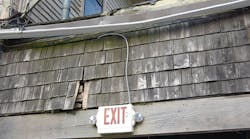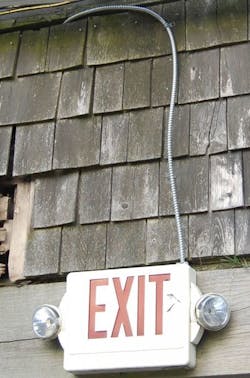How well do you know the Code? Think you can spot violations the original installer either ignored or couldn't identify? Here's your chance to moonlight as an electrical inspector and second-guess someone else's work from the safety of your living room or office. It's your turn to identify the violation.
Hint: Exit, stage left
Find the Answer
Neither this exit sign nor the metal-clad (MC) cable feeding it is designed to be installed in this outdoor wet location.
Section 330.10(11) permits MC cable to be used in a wet location when it includes a corrosion-resistant jacket over the metallic covering, and either the metallic covering is impervious to moisture, or a moisture resistant jacket is provided under the metallic covering, or the insulated conductors inside of it are listed for use in a wet location. In this instance, neither the cable connectors or this type of cable is listed for this application. The use of incorrect cable connectors violates the requirements of Sec. 330.40. Water can easily enter this exit sign since the connector was installed on the top of the sign.
In addition, Sec. 410.10(A) requires luminaires in wet locations to be installed so water cannot enter or accumulate in wiring compartments or other parts of the unit. The luminaire must also be listed and marked “Suitable for Wet Locations.”
And as always, using equipment for installations where it is not listed or labeled for use violates the rule of Sec. 110.3(B).





